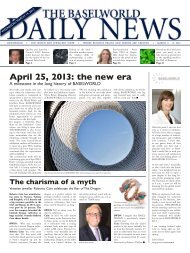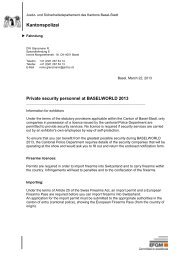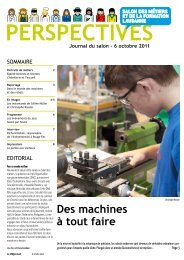WatchTime - August 2012
WatchTime - August 2012
WatchTime - August 2012
Create successful ePaper yourself
Turn your PDF publications into a flip-book with our unique Google optimized e-Paper software.
ing partner Victorin Piguet. The movement contained 19 jewels<br />
and relied on a classic pincer mechanism with an additional column<br />
wheel to control the split-seconds hand. This timepiece<br />
was sold to Tiffany & Co. in New York on Oct. 7, 1924. The<br />
early wristwatch rattrapante models used a button in the crown<br />
to start the chronograph, to stop it, and to return its hands to<br />
their zero positions. The split-seconds mechanism was controlled<br />
via a button at 2 o’clock. These elaborate chronographs<br />
had cushion-shaped gold cases; their dials sometimes included<br />
tachymeter scales to measure average speeds.<br />
Watchmakers began working on movement number<br />
198.012 on May 11, 1925. This was a comparable Victorin<br />
Piguet movement in so-called “Lépine” design, i.e., the runningseconds<br />
subdial and the 30-minute counter were collinear with<br />
the crown. The unusual feature of this timepiece, which was<br />
sold on Jan. 4, 1927, is that all its operating elements were on<br />
the left-hand side of its cushion-shaped case. These included a<br />
little slide between the crown and the split-seconds button,<br />
which was located at 8 o’clock. This slide enabled the owner,<br />
who was probably a southpaw, to block the chronograph function<br />
for added security.<br />
HOW A CLASSIC SPLIT-SECONDS<br />
MECHANISM WORKS<br />
Split-second chronograph watches have<br />
in the center of the dial a pair of seconds<br />
hands to measure elapsed seconds. The<br />
additional seconds hand, which sits atop<br />
the principal elapsed-seconds hand, enables<br />
the timing of intermediate intervals<br />
of time – the laps of a car driving around<br />
a racetrack, for instance – within a longer<br />
period of time. When the chronograph is<br />
switched on, both hands begin to move,<br />
together, as if they were a single hand.<br />
When the first interval ends, the watch<br />
wearer stops the split-seconds hand,<br />
notes the elapsed time, and then restarts<br />
the hand, causing it to jump forward to<br />
catch up with the principal hand, which<br />
has been moving continuously since the<br />
chronograph was started.<br />
This requires a fixed but flexible connection<br />
between the two hands. This connection<br />
shouldn’t sap an unduly large<br />
dose of energy from the movement’s<br />
mainspring and is therefore a very delicate<br />
one. The difficulties begin with<br />
drilling the very long hole through the<br />
staff of the chronograph’s center wheel:<br />
this staff must be quite long because it<br />
The third model in this series (number 198.018, with round<br />
gold case no. 411.525) was shipped on Jan. 31, 1927 to New<br />
York, where Tiffany sold it with its own name on the dial.<br />
Another rattrapante chronograph (movement number<br />
198.076) began in a cushion-shaped gold case in 1927, but<br />
reappeared in a round case in 1935, perhaps because there was<br />
no buyer for it. It left the manufacture one year later. There were<br />
probably not more than a dozen of these very early split-seconds<br />
chronographs.<br />
The economic upheavals that shook the world in the 1930s<br />
had a profound impact on Patek Philippe. A drastic decline in<br />
extends through the entire movement.<br />
Furthermore, the bore hole must be extremely<br />
precise so that the even thinner,<br />
even longer, and extremely straight staff<br />
of the split-seconds wheel can turn with<br />
minimal friction inside the cylindrical<br />
opening. Any eccentricity or bend will<br />
interfere with its proper functioning.<br />
Watchmakers screw the so-called<br />
“split-seconds heart” (colored brown in<br />
the illustration) to the rear of the chronograph’s<br />
center wheel. This wheel later cooperates<br />
with the split-seconds wheel<br />
(pale blue), which is affixed to the splitseconds<br />
staff. The split-seconds wheel<br />
bears the split-seconds lever (dark blue),<br />
which has a little ruby roller on its free<br />
end. A slender steel spring (green) presses<br />
the split-seconds lever so firmly against<br />
the double-hand’s heart that the ruby<br />
roller, because of its shape, rests in the little<br />
notch. This contact suffices to cause<br />
the split-seconds hand to rotate along<br />
with the chronograph’s elapsed-seconds<br />
hand. An “X”-shaped pincers (red), controlled<br />
by a column wheel, stops the splitseconds<br />
hand. The finely toothed ends of<br />
these pincers act like a shoe brake. If the<br />
thicker parts on either side of this pincers<br />
rest atop pillars of the split-seconds column<br />
wheel (yellow), then the brake is released<br />
so the split-seconds hand and its<br />
companion rotate together.<br />
When the user presses the<br />
rattrapante button, the column wheel<br />
turns and advances one position. The descent<br />
of the thickened parts between the<br />
columns closes the pincers (illustration on<br />
the left). The two arms press against the<br />
split-seconds wheel and thus stop the<br />
split-seconds hand. In this instance, the<br />
ruby roller runs along the circumference<br />
of the split-seconds heart. When the pincers<br />
reopen, the spring’s pressure guides<br />
the roller into the notch in the heart, and<br />
the split-seconds hand catches up with<br />
the chronograph’s elapsed-seconds hand<br />
(illustration on the right). As long as the<br />
chronograph is running, this interplay can<br />
be repeated as often as the user desires.<br />
Split-seconds constructions also exist with<br />
parallel pincers. The function is exactly reversed<br />
in this case: prongs that descend<br />
between the columns open the pincers.<br />
<strong>August</strong> <strong>2012</strong> <strong>WatchTime</strong> 55

















